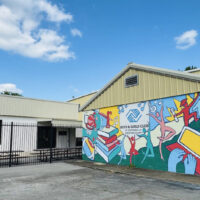One animating issue for voters in the 2022 midterm elections — especially for Republicans — was the country’s broken immigration system. Another issue that was top-of-mind for families of both parties trolling the supermarket aisles was inflation.
Waiting in the wings is a federal policy that could address both of these problems.
With bipartisan support, the Farm Workforce Modernization Act passed twice in the House and is pending in the Senate. Could the lame-duck session provide the spur that kicks it into gear?

Enacting it wouldn’t relieve the crush of arrivals at the southern border or lower the price of gas at the pump. But it would ease the labor shortage that is driving farmers out of business and reward essential workers who put food on our tables, many of whom have been doing so without immigration status for more than a decade.
More workers picking lettuce and milking cows could populate grocery shelves at lower prices and add stability to food supply chains.
The legislation has two principal parts. It creates a new, temporary immigration status — Certified Agricultural Worker (CAW) — authorizing the residence and labor of qualified, undocumented farmworkers and their families. It also then grants legal permanent residency (a “green card”) to those who pay a fine, pass background checks, and make a commitment to continue working in agriculture.
It also makes changes to the main American guestworker program (commonly called H-2A), expanding it to employers with year-round labor needs like dairy farms and improving worker protections that labor groups have long requested. Both proposals contemplate a path to citizenship for some participants, albeit after many years.
Today’s labor shortage has been a long time coming and is not wholly attributable to the declining availability of American workers. Between 1950 and 2000 the number of farmers and family members working on the farm dwindled by 73%and the number of hired workers by 52%. Automation of many agricultural functions reduced the need for human labor, and corporate dominance in agriculture meant disinvestment in family farming. But machines and robots can’t do everything, and the precipitous drop between 1950 and 1990 left farmers desperately needing more crop and livestock workers than the million or so that remained in 2019.
Recruiting domestic laborers in agriculture has become a thankless task. American workers who have alternatives to the low-paid, arduous work of farming have largely abandoned it; only 30% of farmworkers surveyed in 2020 were U.S.-born. Young people who would like to farm face formidable obstacles to moving beyond cropworker status: high cost of land and equipment, volatile weather and prices, round-the-clock demands on time and energy.
But farming is an employment opportunity for immigrants, particularly those who arrive without technical skills or much education. During the 21st century so far, the proportion of foreign-born has held steady at just under three-quarters of crop workers, of whom just under half are undocumented. Unlike earlier eras, most immigrants — 85% according to the Labor Department’s National Agricultural Worker Survey — are what demographers call “settled workers,” meaning that they live within commuting distance of their workplaces and do not migrate seasonally.
Furthermore, they are not recent arrivals. A majority have been in the U.S. 15 years or more, and at least half are married with children. Recent surveys find that these workers intend to continue in farming for the foreseeable future. So they are embedded in American economic and cultural life, which ought to count for something in the evaluation of claims to permanent residency or citizenship.
This may seem an odd moment to expect bipartisan cooperation for plans to bring more foreign-born people into the country and legalize some who are here illegally when political polarization has made the influx of migrants at our southern border almost impossible to manage. Some resistance does exist, with right-wing opponents calling the provisions “amnesty” and some immigrant groups critical of the length of the law’s path to citizenship.
Some resistance does exist, with right-wing opponents calling the CAW program “amnesty” and some immigrant groups worrying about the continuing exploitation of workers and complaining about the length of the program’s path to citizenship.
But the legislation has overwhelming support among the people most affected, farmers and their workers. All over the country farmers’ associations are urging members to lobby their Senators for passage—sixty groups sent representatives to Washington last week to do just that—and Bruce Goldstein, Director of Farmworker Justice, has legitimized the law by calling it “a labor-management agreement.”
The politicians most responsible for moving the bill from the House to the Senate — Mike Crapo (R-Idaho) and Michael Bennet (D-Colorado) — will be dealing with many pesky details, including the American Farm Bureau Federation’s opposition to a provision that would permit H-2A workers to take their employers to court for exploitative working and living conditions. Garnering enough support from their Republican colleagues to pass the bill by the end of the month is a daunting task.
On the other hand, the Senators’ authority may be strengthened by the fact that both just won re-election. And they will be feeling the pressure of agriculture’s labor crisis. As a prominent wholesaler warns, “If they don’t get it done, our next chance will be years down the road and farms will go out of business by then.”
This article first appeared on The Daily Yonder and is republished here under a Creative Commons license.
Diana Gordon is professor emerita of political science of the City University of New York. She writes about immigration policy and is the author of Village of Immigrants: Latinos in an Emerging America. Her website is smalltownimmigration.com.


